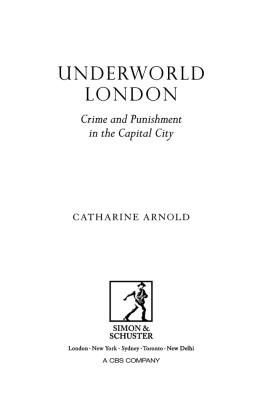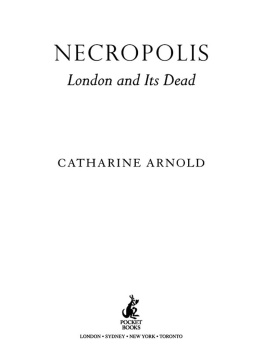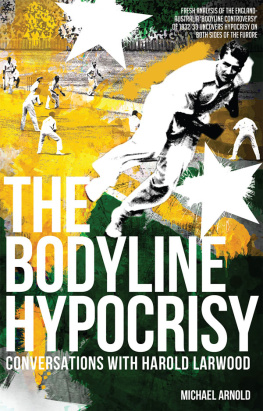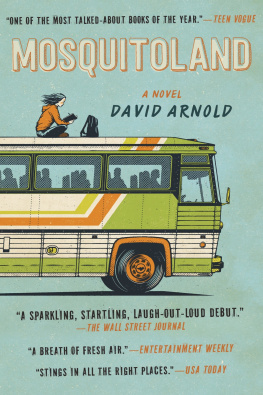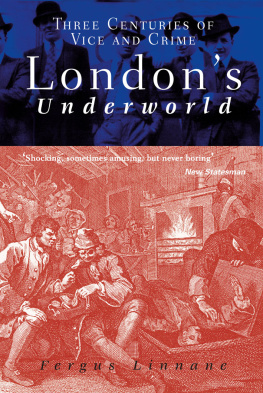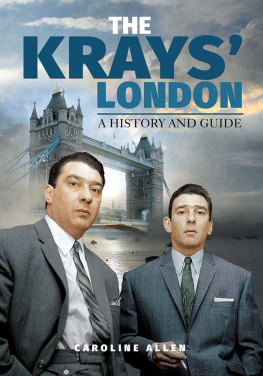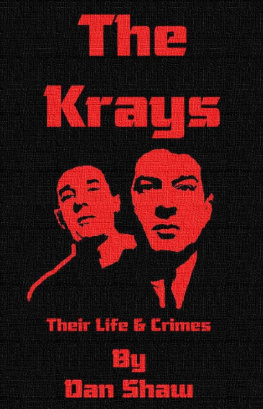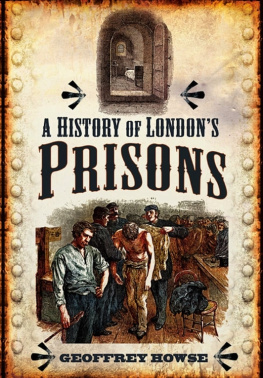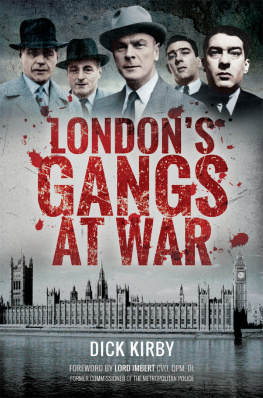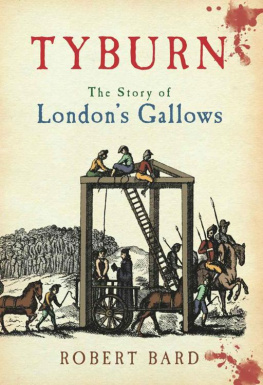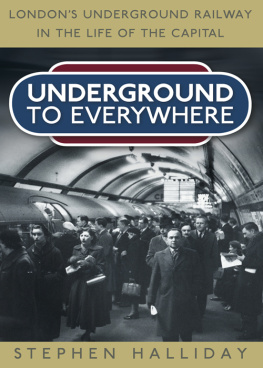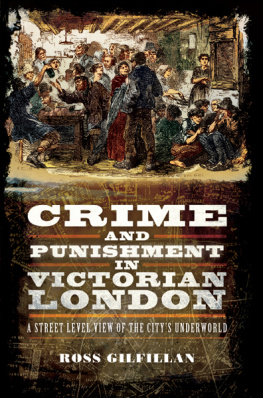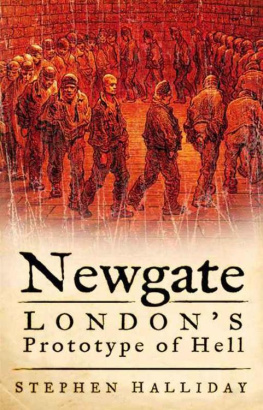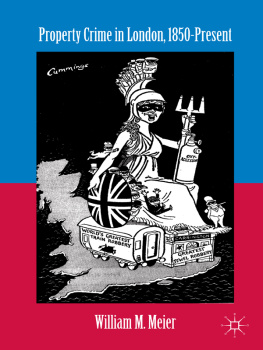UNDERWORLD
LONDON
Also by Catharine Arnold
THE SEXUAL HISTORY OF LONDON: From Roman
Londinium to the Swinging City
CITY OF SIN: London and Its Vices
BEDLAM: London and Its Mad
NECROPOLIS: London and Its Dead

First published in Great Britain by Simon & Schuster UK Ltd, 2012
A CBS COMPANY
Copyright Catharine Arnold 2012
This book is copyright under the Berne Convention.
No reproduction without permission.
and 1997 Simon & Schuster Inc. All rights reserved.
The right of Catharine Arnold to be identified as author of this work has been asserted by her in accordance with sections 77 and 78 of the Copyright, Designs and Patents Act, 1988.
The publishers have made every effort to contact those holding rights in the material reproduced in this book. Where this has not been possible, the publishers will be glad to hear from those who recognise their material.
Simon & Schuster UK Ltd
1st Floor
222 Grays Inn Road
London
WC1X 8HB
www.simonandschuster.co.uk
Simon & Schuster Australia, Sydney
Simon & Schuster India, New Delhi
A CIP catalogue record for this book is available from the British Library
ISBN: 978-0-85720-116-4
eBook ISBN: 978-0-85720-117-1
Typeset by M Rules
Printed and bound by CPI Group (UK) Ltd, Croydon, CR0 4YY
For my husband
Till a the seas gang dry, my dear,
And the rocks melt wi the sun:
I will luve thee still, my dear,
While the sands o life shall run.
Robbie Burns
Contents
Acknowledgements
With grateful thanks to Cambridge University Library; the Hallward Library at the University of Nottingham; my agent, Charlie Viney; my editor, Kerri Sharp; Dr Simon Lee Price for his generous and helpful comments; Sue Stephens and Rory Scarfe at Simon & Schuster; Brian Catling for allowing me to share the inscription from his beautiful memorial at Tower Green; Paul Willetts; Lucille Venn; and most of all my wonderful family.
Many cart-loads of our fellow-creatures are once in six weeks carried to slaughter.
Henry Fielding, 1751
The following malefactors were executed at Tyburn John Kelly, for robbing Edward Adamson in a public street of sixpence and one farthing.
Gentlemans Magazine, 7 March 1783
It is frequently said by the prisoners of Newgate that the crimes of which they have been guilty are as nothing when compared with the crimes of Government towards themselves: that they have only been thieves, but that their governors have been murderers.
Mrs Elizabeth Fry, prison reformer, 1818
Introduction
Imagine that you are standing at Marble Arch today, looking east, down the vista of eight hundred years. Picture an innumerable procession of men and women advancing from the mist, walking to their deaths from the Tower of London or Newgate Gaol to the bloody field of Tyburn. Historians can only surmise the number of those who suffered violent death here, but a modest estimate would put the figure at around 50,000. This black parade is composed of all sorts and conditions of men, from aristocrats to artisans, priests to petty thieves, and notorious murderers to young boys who have stolen a few pennies. Learned scholars and priests rub shoulders with illiterate thugs. Highwaymen swagger in their finery while fraudulent clerks twitch nervously. There are women here, too: an unrepentant murderess resplendent in black satin and an innocent maiden in her white bridal gown. Alongside them stride rebels and martyrs whose only crime was to refuse to renounce their cherished beliefs at the bidding of a tyrant.
Tyburns dead travel along this Via Dolorosa in different ways. Some are bound with rope, tied to a horse and dragged five miles from the Tower. The majority ride in horse-drawn carts, alongside their coffins. This is, for the most part, a nameless, unrecorded crowd. Over the centuries, only the occasional figure emerges here and there from the anonymous throng. It is just for a few decades in the history of Tyburn that we will see certain characters from this procession clearly, and in detail. Mainly they pass in faceless batches of ten, fifteen, twenty: laughing boys; women with babies at the breast; men and women drunk, cursing, crying, praying. Some of the women will be burnt alive. Of the men, all will hang, but some will be cut down, still conscious, and forced to watch as they are disembowelled and their entrails burnt before their very eyes. A few will be hanged in chains or placed in a gibbet until the flesh rots from their bones. Alongside these unfortunates march the spectators, the family and friends of the dead, and those who consider public executions to be first-rate entertainment. For centuries, hangings were holidays, offering all the fun of the Tyburn fair. The crowd gorged on gingerbread, roast pork and beer, before shouting Hats off! and craning to see the condemned men kicking their way to death at the end of a short rope.
Barbaric by modern standards, public executions were a common sight up until 1868. In 1660, the diarist Samuel Pepys went to see Major-General Harrison hanged, drawn and quartered, and observed that he looked as cheerful as any man could in that condition. He was presently cut down, and his head and his heart shown to the people, at which there was great shouts of joy. Pepys also witnessed the hanging of Colonel John Turner for burglary in 1664. After paying a shilling to watch, Pepys stood on the wheel of a cart, in great pain, as Turner tried to delay his death by delivering speech after speech. Turner was eventually hanged, flung off the ladder in his cloak and Pepys went home to dinner all in a sweat. Pepys also saw a number of gibbets. During a country ride, he and a female companion rode under the man that hangs upon Shooters Hill; and a filthy sight it was to see how his flesh is shrunk to his bones.
The 1752 Murder Act allowed judges to make an example of murderers by ordering that their corpses should be displayed on a gibbet. Thus, in the 1770s, up to one hundred gibbets stood on Hounslow Heath, so that, according to the poet Robert Southey, from whatever quarter the wind blew, it brought with it a cadaverous and pestilential odour. The Sunday after the highwayman Lewis Avershaw was gibbeted on Wimbledon Common in 1795, the city was deserted as Londoners flocked to view the corpse. For months after, this grisly spectacle was a popular outing.
Taking Tyburn and the history and abolition of capital punishment as its major theme, this book visits the major landmarks of Londons underworld. In the course of this journey, I introduce the reader to Newgate Gaol, described by the barrister Henry Fielding as Londons prototype of Hell, and its equally famous neighbour, the venerable Old Bailey. There is the chance to canter across the moonlit Common with the highwaymen, learn the secrets of top pickpockets in the Victorian West End, and venture into the dark and deadly territory of Whitechapel on the trail of Jack the Ripper. From time to time, the narrative will be interrupted, just as London has been, by insurrection, from the Gordon Riots of 1780 which saw Newgate Gaol burnt to the ground, to the disturbances of August 2011.
The horrific history of capital punishment includes an extraordinary cast of characters, from the celebrated Newgate escapee Jack Sheppard to the evil thief-taker Jonathan Wild, from the mild-mannered Doctor Crippen to the glittering ash-blonde Ruth Ellis, the last woman to be hanged. This tour of the capitals underworld is not for the faint-hearted. Beneath the veneer of sophistication and culture lurks a lawless London, a substratum of passion, darkness and despair. The legacy of this lingers on in the incipient melancholy of the London street, the abiding sense of mystery and unsolved crimes, of footsteps echoing in the distance, the flick of a cape, the discovery of a battered corpse lying in a pool of blood. Murderers cast a long shadow. Even today, serving police officers post in chat rooms, speculating on the true identity of Jack the Ripper and other unsolved crimes. Who can forget the image of Lady Lucan, staggering out of her Belgravia home with a massive head wound, after her husband Lord Lucan had apparently murdered their nanny, Sandra Rivett, mistaking her for his wife? Or the glittering, violent career of the Kray twins local heroes, celebrity socialites and ruthless murderers?

